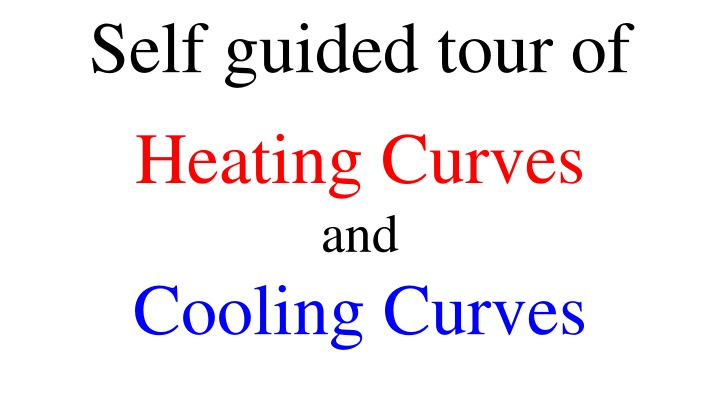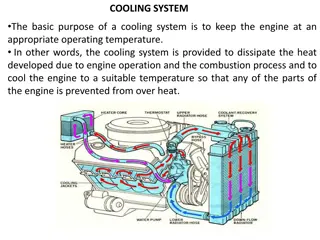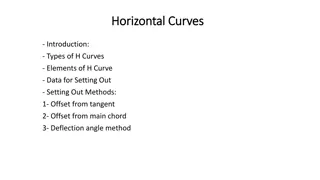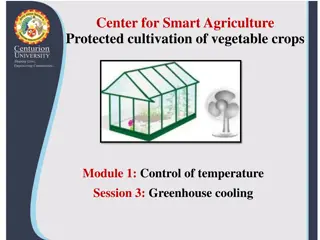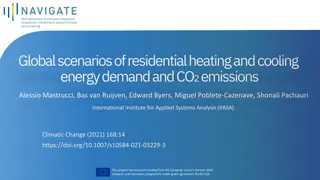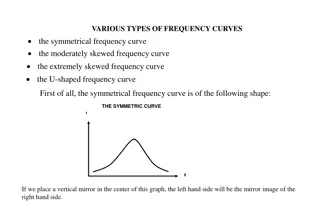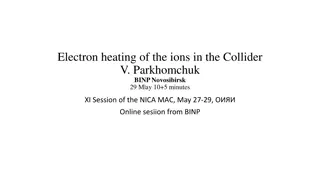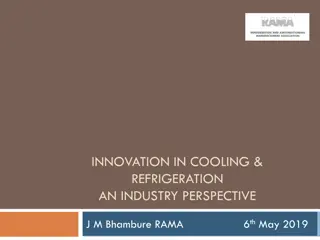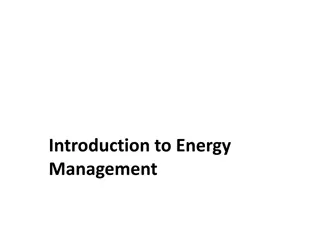Self guided tour of Heating Curves and Cooling Curves
Delve into the comprehensive study of heating and cooling curves. Understand the transformation of substances as heat energy is applied, observing phase changes from solid to gas. Follow step-by-step instructions to create graphs depicting temperature variations over time, focusing on water at different temperatures. Interpret the significance of kinetic energy, potential energy, and phase transitions during the process. Gain insights into the behavior of ice and water at varying temperatures, highlighting the importance of the melting point. Engage in a visually guided self-exploration of the fascinating world of thermal dynamics.
Download Presentation

Please find below an Image/Link to download the presentation.
The content on the website is provided AS IS for your information and personal use only. It may not be sold, licensed, or shared on other websites without obtaining consent from the author.If you encounter any issues during the download, it is possible that the publisher has removed the file from their server.
You are allowed to download the files provided on this website for personal or commercial use, subject to the condition that they are used lawfully. All files are the property of their respective owners.
The content on the website is provided AS IS for your information and personal use only. It may not be sold, licensed, or shared on other websites without obtaining consent from the author.
E N D
Presentation Transcript
Self guided tour of Heating Curves and Cooling Curves
A heating curve shows what happens as you add heat energy to a substance over time. Usually, this heat energy is added at a constant rate. That means this: you put a pot of ice onto a gas stove that is already lit. You watch what happens to this ice, over time in minutes and see it PHASE CHANGE from SOLID ICE LIQUID WATER STEAM GAS
You will go step by step through a heating curve now. You need 2 pieces of graph paper and a ruler. Copy exactly as you see, put the title where I show you, and the boxes where I show you too. That way it will fit correctly. Start out LANDSCAPE position, draw the X and Y axis lines, add the axis labels and the title (where I show it). Then you will make graph #2, the cooling curve. A title page will include your name, class period, and two sentences, explaining what the titles of your graphs really mean in English.
Heating Curve for H2O Temperature in Kelvin Heat energy added constantly, over time
Add the 2 temperatures for water that matter, 273 K and 373 K. Put in ZERO K too. Add in time 0 as well. Heating Curve for H2O 373 K ADD BOXES TOO Temperature in Kelvin They will disappear from the slides until later on, but draw them now. 273 K 0 K Heat energy added constantly, over time 0
ADD THOSE BOXES NOW Heating Curve for H2O They will disappear from the slides until later. Draw them now. 373 K Temperature in Kelvin Kinetic Energy Potential Energy Segment PHASE TEMP AB BC 273 K CD DE EF 0 K Heat energy added constantly, over time 0
Draw in the starting point temperature for the ice, higher than zero Kelvin, but very cold. Mark it A Heating Curve for H2O 373 K Temperature in Kelvin 273 K A 0 K Heat energy added constantly, over time 0
Imagine really, really cold ice, like at point A . If you add heat energy, it will get warmer. That s weird, cold ice and warm ice, but ice can be different temps too, just like metals. Cold frying pan, hot frying pan. As we add heat the temperature of the ice rises, until we get to that SPECIAL temperature for water, the MELTING POINT. Heating Curve for H2O 373 K Temperature in Kelvin B Draw the line segment AB. 273 K A 0 K Heat energy added constantly, over time 0
It gets weird at point B. Here we are still ADDING HEAT ENERGY at a constant rate, but the temperature does not increase. Heating Curve for H2O 373 K All of the energy goes into the solid ice to MELT IT. Temperature in Kelvin During a phase change, temperature remains constant. Draw BC now. B 273 K C A 0 K Heat energy added constantly, over time 0
BC is THE melting point. There is only one special temperature for ice to melt, it s 273 Kelvin = 0 Centigrade. Heating Curve for H2O 373 K This is one temperature that you already know. This temperature never VARIES, it s one of the important CONSTANTS for water. Temperature in Kelvin B 273 K C A 0 K Heat energy added constantly, over time 0
At point B the H20 is all solid. Heating Curve for H2O At point C it s all liquid. Between B and C, the phase changes from S L 373 K D Temperature in Kelvin Once all the H2O is liquid, extra heat energy added will increase the temperature, all the way to the other important temperature for water, 373 Kelvin. B 273 K Draw CD now. C A 0 K Heat energy added constantly, over time 0
At D the water is as hot as it can get, while staying liquid. At this point, the temperature stays steady as the liquid changes phase to gas. Heating Curve for H2O 373 K D E Temperature in Kelvin This takes MORE energy than to melt, so DE will be LONGER in length that BC. Draw DE now. B 273 K C A 0 K Heat energy added constantly, over time 0
DE is THE boiling point. There is only one temperature for water to boil, it s 373 Kelvin = 100 Centigrade. Heating Curve for H2O 373 K D E Temperature in Kelvin This is THE special temperature that you already know. This temperature never VARIES, it s one of the important CONSTANTS for water. B 273 K C A 0 K Heat energy added constantly, over time 0
Heating Curve for H2O F 373 K D E Temperature in Kelvin Once the H2O is ALL GAS at point E, then added heat energy will increase the temperature. Extra heat makes the H2O as hot as you can make it. B 273 K C Draw in EF with an arrowhead on the line. A 0 K Heat energy added constantly, over time 0
We will start with the boxes in the next slide. The heating curve graph is done now. Heating Curve for H2O F 373 K D E Temperature in Kelvin Kinetic Energy Potential Energy Segment PHASE TEMP AB BC B 273 K CD C DE A EF 0 K Heat energy added constantly, over time 0
Phases: from A to B, the H2O is solid and stays solid, the phase is SOLID. Heating Curve for H2O F The temperature is going up though, so temp INCREASES. 373 K D E Temperature in Kelvin Kinetic Energy Potential Energy Segment PHASE TEMP SOLID INC AB BC B 273 K CD C DE A EF 0 K Heat energy added constantly, over time 0
Phases: from B to C, the H2O solid begins to melt into a liquid. Both phases in this segment. Heating Curve for H2O F The temperature is Steady here. 373 K D E Temperature in Kelvin Kinetic Energy Potential Energy Segment PHASE TEMP SOLID INC AB S L BC STEADY B 273 K CD C DE A EF 0 K Heat energy added constantly, over time 0
Phases: from C to D, the H2O liquid just gets warmer. Only the liquid phase here. Heating Curve for H2O F The temperature is Increases here. 373 K D E Temperature in Kelvin Kinetic Energy Potential Energy Segment PHASE TEMP SOLID INC AB S L BC STEADY B LIQUID 273 K INC CD C DE A EF 0 K Heat energy added constantly, over time 0
Phases: D to E, the H2O liquid changes into a gas. Both phases here. Heating Curve for H2O F The temperature is STEADY here. 373 K D E Temperature in Kelvin Kinetic Energy Potential Energy Segment PHASE TEMP SOLID INC AB S L BC STEADY B LIQUID 273 K INC CD C L G DE STEADY A EF 0 K Heat energy added constantly, over time 0
Phases: E to F (and beyond), the H2O gas stays gas. The temperature is INCREASES here. Heating Curve for H2O F 373 K D E Temperature in Kelvin Kinetic Energy Potential Energy Segment PHASE TEMP SOLID INC AB S L BC STEADY B LIQUID 273 K INC CD C L G DE STEADY A GAS INC EF 0 K Heat energy added constantly, over time 0
Next up is Kinetic energy, which is the energy of motion or another way to think about temperature. Hot means particles move faster, higher KE, while colder means particles move slower, LOWER KE. Heating Curve for H2O F 373 K D E Temperature in Kelvin Kinetic Energy Potential Energy Segment PHASE TEMP SOLID INC AB S L BC STEADY B LIQUID 273 K INC CD C L G DE STEADY A GAS INC EF 0 K Heat energy added constantly, over time 0
AB: while temperature increases, so does KE, so the kinetic energy of segment AB is increasing. Heating Curve for H2O F 373 K D E Temperature in Kelvin Kinetic Energy Potential Energy Segment PHASE TEMP SOLID INC AB INC S L BC STEADY B LIQUID 273 K INC CD C L G DE STEADY A GAS INC EF 0 K Heat energy added constantly, over time 0
BC: while temperature is steady, the KE does not change either. There is no increase in temp, which translates to no change in the kinetic energy either. Heating Curve for H2O F 373 K D E Temperature in Kelvin Kinetic Energy Potential Energy Segment PHASE TEMP SOLID INC AB INC S L BC STEADY STEADY B LIQUID 273 K INC CD C L G DE STEADY A GAS INC EF 0 K Heat energy added constantly, over time 0
CD: while temperature increases, so does KE, so the kinetic energy of segment CD is increasing. Heating Curve for H2O F 373 K D E Temperature in Kelvin Kinetic Energy Potential Energy Segment PHASE TEMP SOLID INC AB INC S L BC STEADY STEADY B LIQUID 273 K INC CD INC C L G DE STEADY A GAS INC EF 0 K Heat energy added constantly, over time 0
DE has no change in temp, so there is no change in KE either. Heating Curve for H2O F 373 K D E Temperature in Kelvin Kinetic Energy Potential Energy Segment PHASE TEMP SOLID INC AB INC S L BC STEADY STEADY B LIQUID 273 K INC CD INC C L G DE STEADY STEADY A GAS INC EF 0 K Heat energy added constantly, over time 0
EF shows increase in temperature which means an increase in the kinetic energy too. Heating Curve for H2O F 373 K D E Temperature in Kelvin Kinetic Energy Potential Energy Segment PHASE TEMP SOLID INC AB INC S L BC STEADY STEADY B LIQUID 273 K INC CD INC C L G DE STEADY STEADY A GAS INC EF INC 0 K Heat energy added constantly, over time 0
Potential Energy is different and new When particles move faster, when the KE , that registers as HOTTER temperature. The reverse is the same, when the KE , that regsiters as LOWER Kinetic Energy. Heating Curve for H2O F 373 K D E Temperature in Kelvin Kinetic Energy Potential Energy Segment PHASE TEMP SOLID INC AB INC S L BC STEADY STEADY B LIQUID 273 K INC CD INC C L G DE STEADY STEADY A GAS INC EF INC 0 K Heat energy added constantly, over time 0
Potential Energy is better thought of as the energy of phase . Solids have the LOWEST PE, liquids have medium PE, and gases have the highest PE. Heating Curve for H2O F 373 K D E Temperature in Kelvin Kinetic Energy Potential Energy Segment PHASE TEMP SOLID INC AB INC S L BC STEADY STEADY B LIQUID 273 K INC CD INC C L G DE STEADY STEADY A GAS INC EF INC 0 K Heat energy added constantly, over time 0
If temperature changes, but the phase does not, say from A to B, then the PE is constant. The Kinetic energy changes with the temperature, but if the phase stays the same, so does the potential energy. Heating Curve for H2O F 373 K D E Temperature in Kelvin Kinetic Energy Potential Energy Segment PHASE TEMP SOLID INC AB INC STEADY S L BC STEADY STEADY B LIQUID 273 K INC CD INC C L G DE STEADY STEADY A GAS INC EF INC 0 K Heat energy added constantly, over time 0
From B to C the temp, and the KE are steady during the phase change. The solid becomes a liquid, that is an increase in the potential energy. Heating Curve for H2O F 373 K D E Temperature in Kelvin Kinetic Energy Potential Energy Segment PHASE TEMP SOLID INC AB INC STEADY S L BC INC STEADY STEADY B LIQUID 273 K INC CD INC C L G DE STEADY STEADY A GAS INC EF INC 0 K Heat energy added constantly, over time 0
From C to D the temp increases, and so does the KE. The phase is liquid and stays liquid. The phase doesn t change, and neither does the potential energy. Heating Curve for H2O F 373 K D E Temperature in Kelvin Kinetic Energy Potential Energy Segment PHASE TEMP SOLID INC AB INC STEADY S L BC INC STEADY STEADY B LIQUID 273 K INC CD INC STEADY C L G DE STEADY STEADY A GAS INC EF INC 0 K Heat energy added constantly, over time 0
DE is the hot phase change, from liquid to gas. Temp and KE are steady, but the PE as the liquid moves to a higher phase of gas. Heating Curve for H2O F 373 K D E Temperature in Kelvin Kinetic Energy Potential Energy Segment PHASE TEMP SOLID INC AB INC STEADY S L BC INC STEADY STEADY B LIQUID 273 K INC CD INC STEADY C L G DE INC STEADY STEADY A GAS INC EF INC 0 K Heat energy added constantly, over time 0
E to F the steam (gas) temp increases and the particles are moving faster (higher KE). The gas stays gas, the phase does not change, so the PE is steady. Heating Curve for H2O F 373 K D E Temperature in Kelvin Kinetic Energy Potential Energy Segment PHASE TEMP SOLID INC AB INC STEADY S L BC INC STEADY STEADY B LIQUID 273 K INC CD INC STEADY C L G DE INC STEADY STEADY A GAS INC EF INC STEADY 0 K Heat energy added constantly, over time 0
This is a COMPLETE HEATING CURVE for water. Heating Curve for H2O F 373 K D E Temperature in Kelvin Kinetic Energy Potential Energy Segment PHASE TEMP SOLID INC AB INC STEADY S L BC INC STEADY STEADY B LIQUID 273 K INC CD INC STEADY C L G DE INC STEADY STEADY A GAS INC EF INC STEADY 0 K Heat energy added constantly, over time 0
If I changed the title to heating curve for COPPER, the same graph works. Heating Curve for H2O F 373 K D E Temperature in Kelvin Kinetic Energy Potential Energy Segment PHASE TEMP SOLID INC AB INC STEADY S L BC INC STEADY STEADY B LIQUID 273 K INC CD INC STEADY C L G DE INC STEADY STEADY A GAS INC EF INC STEADY 0 K Heat energy added constantly, over time 0
But Id have to change the melting point temp, and the BP temp too. Otherwise, it s identical. Boxes too. Heating Curve for Cu F 2835 K D E Temperature in Kelvin Kinetic Energy Potential Energy Segment PHASE TEMP SOLID INC AB INC STEADY S L BC INC STEADY STEADY B LIQUID 1358 K INC CD INC STEADY C L G DE INC STEADY STEADY A GAS INC EF INC STEADY 0 K Heat energy added constantly, over time 0
Every heating curve in chemistry is THE SAME, except for the temperature of melting and boiling, and the title. The same curve, and the same stuff happens at each segment, temperature and kinetic energy change or stay steady, and the PE changes or is steady in the same segments. Only the size of the Y axis scale, the temperature scale, and the title, adjust. One size mostly fits ALL ELEMENTS and all compounds.
The opposite of HEATING is cooling. Cooling curves are jut heating curves, in reverse. Make the graph for the COOLING CURVE FOR WATER. This is the EXACT same set up as we did in the first graph. Title to the right, BOXES to the left. COOLING Curve for H2O 373 K Temperature in Kelvin Kinetic Energy Potential Energy Segment PHASE TEMP AB BC 273 K CD DE EF 0 K Heat energy REMOVED constantly, over time 0
Pick a point to start, really, really hot, above the BP. Label this A. A COOLING Curve for H2O 373 K Temperature in Kelvin Kinetic Energy Potential Energy Segment PHASE TEMP AB BC 273 K CD DE EF 0 K Heat energy REMOVED constantly, over time 0
As heat is removed, the gas temperature lowers, but remains ABOVE the BP, so the gas remains gas. LOOK in the AB line of boxes. Temp drops, so does the KE (they are the same). PE is steady since the phase DOES NOT CHANGE in this segment. A COOLING Curve for H2O 373 K B Temperature in Kelvin Kinetic Energy Potential Energy Segment PHASE TEMP AB GAS STEADY DEC DEC BC 273 K CD DE EF 0 K Heat energy REMOVED constantly, over time 0
As heat is removed, the gas temperature lowers, but remains ABOVE the BP, so the gas remains gas. LOOK in the AB line of boxes. Temp drops, so does the KE (they are the same). PE is steady since the phase DOES NOT CHANGE in this segment. A COOLING Curve for H2O 373 K C B Temperature in Kelvin Kinetic Energy Potential Energy Segment PHASE TEMP AB GAS STEADY DEC DEC BC STEADY STEADY G L DEC 273 K CD DE EF 0 K Heat energy REMOVED constantly, over time 0
A COOLING Curve for H2O BC is THE condensing point. There is only one temperature for steam to condense, that is 373 Kelvin = 100 Centigrade. 373 K C B Temperature in Kelvin Kinetic Energy Potential Energy Segment PHASE TEMP This is THE special temperature that you already know. This temperature never VARIES, it s one of the important CONSTANTS for water. AB GAS STEADY DEC DEC BC STEADY STEADY G L DEC 273 K CD DE EF 0 K Heat energy REMOVED constantly, over time 0
For segment CD, the temperature drops as the liquid cools, all the way to the special temperature of 273 Kelvin. LOOK AT THE BOXES HERE TOO. The phase remains liquid, no change in phase, no change in potential energy either. A COOLING Curve for H2O 373 K C B Temperature in Kelvin Kinetic Energy Potential Energy Segment PHASE TEMP AB GAS STEADY DEC DEC BC STEADY STEADY G L DEC 273 K CD LIQ STEADY DEC DEC D DE EF 0 K Heat energy REMOVED constantly, over time 0
For DE, the water changes from cold liquid to SOLID ICE, a phase change. Temperature is constant, so KE is constant too. But the potential decreases from liquid to solid. LOOK AT BOXES. A COOLING Curve for H2O 373 K C B Temperature in Kelvin Kinetic Energy Potential Energy Segment PHASE TEMP AB GAS STEADY DEC DEC BC STEADY STEADY E G L DEC 273 K CD LIQ STEADY DEC DEC D DE STEADY STEADY L S DEC EF 0 K Heat energy REMOVED constantly, over time 0
A COOLING Curve for H2O 373 K C B Temperature in Kelvin DE is THE freezing point. There is one special temperature for water to freeze it s 273 Kelvin = 0 Centigrade. E This is one temperature that you already know. This temperature never VARIES, it s one of the important CONSTANTS for water. 273 K D 0 K Heat energy REMOVED constantly, over time 0
EF we get a cooling of solid ice from cold to even colder. A change in temp means a change in KE. Since the solid stays solid, the PE doesn t change here, it s steady. A COOLING Curve for H2O 373 K C B Temperature in Kelvin Kinetic Energy Potential Energy Segment PHASE TEMP AB GAS STEADY DEC DEC BC STEADY STEADY E G L DEC 273 K CD LIQ STEADY DEC DEC F D DE STEADY STEADY L S DEC EF SOLID STEADY DEC DEC 0 K Heat energy REMOVED constantly, over time 0
This is the COMPLETE COOLING CURVE for water. A COOLING Curve for H2O 373 K C B Temperature in Kelvin Kinetic Energy Potential Energy Segment PHASE TEMP AB GAS STEADY DEC DEC BC STEADY STEADY E G L DEC 273 K CD LIQ STEADY DEC DEC F D DE STEADY STEADY L S DEC EF SOLID STEADY DEC DEC 0 K Heat energy REMOVED constantly, over time 0
Its the SAME curve for all substances, just change the title, and change the Condensing point and freezing point temperatures. SAME for all. A COOLING Curve for H2O 373 K C B Temperature in Kelvin Kinetic Energy Potential Energy Segment PHASE TEMP AB GAS STEADY DEC DEC BC STEADY STEADY E G L DEC 273 K CD LIQ STEADY DEC DEC F D DE STEADY STEADY L S DEC EF SOLID STEADY DEC DEC 0 K Heat energy REMOVED constantly, over time 0
A few last things You can heat substances indefinitely in your mind, in truth, if things get hot enough, like in the center of the Sun, chemical bonds will break apart and compounds will blow apart into atoms. No matter how cold you cool a substance down to, it s always higher than 0 KELVIN. Nothing can be absolute zero. All heating curves are nearly identical, except for titles, and the melting and boiling point temperatures. All cooling curves are nearly identical, except for titles, and the condensing point and freezing point temperatures. SOLID LIQUID (melting) or LIQUID SOLID (freezing) both happen AT ONE CONSTANTTEMP. FP = MP GAS LIQUID (condensing) or LIQUID GAS (boiling) both happen AT ONE CONSTANT TEMP. CP = BP The HOT PHASE CHANGE line is always longer than the COLD PHASE CHANGE line on both heating curves and cooling curves. (Boiling takes more energy, condensing releases more energy) than melting or freezing on the colder phase change. The hot phase change (boiling or condensing) is a bigger energy event
